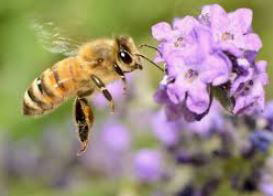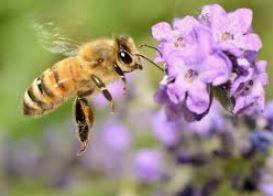How Do Bees Make Honey?


In the peak summer months a worker bee literally works herself to death visiting flowers and transporting the precious cargo back to the hive. During this frenzied time of activity in preparation for the coming winter, a worker bee only lives approximately 35 days. At the end of her days, her wings become so frayed that her usefulness is over and she is rejected by the colony. Honey bees obtain two things from flowers: nectar (for honey production) and pollen. As the female worker bee sucks nectar from flowers, it is stored in her special honey stomach which she uses as a “nectar backpack”. This is completely separate from her digestive stomach although there is a valve connecting the two which she can open when hungry. This allows her to pass through some honey to be converted to energy for her own needs. After visiting between 150 to 1500 flowers, the honey stomach is full and almost equal in weight to bee herself. At this point the worker bee laboriously returns to the hive with her load. The worker bees retuning to the hive laden with nectar are often confused with other workers returning with pollen (they never do both on the same trip). Worker bees have hair-like “baskets” on their hind legs and it is into these that they pack pollen grains while visiting flowers. These bees are easily identified because of the brightly colored orange (and sometimes yellow) pollen packed into their baskets. They present an almost comical appearance as they “waddle” about the hive carrying their oversized loads of pollen. The pollen is sometimes referred to as “bee-bread”, and when mixed with honey forms the diet of the next cycle of brood being raised in the hive. When inspecting the brood combs of a hive, a multicolored ring of pollen can normally be observed encircling the brood in the center of the comb. A bee returning to the hive with a load of nectar is almost immediately greeted by other workers ready to relieve her of the load. A mouth to mouth transfer is normally done between a field bee and one of the hive bees as the adjacent photo shows. Notice the extended “tongues”. The recipient bee processes the honey in its mouth and honey stomach by the addition of enzymes that break the complex sugars in the nectar into simple sugars that is both more digestible by the bees and ultimately gives the honey its characteristic long “shelf life”. Nectar returned to the hive at this point is barely recognizable as honey. The nectar initially is nearly 80% water with the remainder consisting primarily of complex sugars. After processing the honey with enzymes, small droplets are typically deposited on the upper side of a cell wall awaiting its final conversion into viscous honey with which we humans are acquainted. This conversion is largely an evaporation process which, in turn, is hastened by the warm temperature (95 degrees F) maintained in the hive and the movement of air across the honey combs. Leaving nothing to chance, the bees actually control the movement of air by fanning their wings in a coordinated effort. The buzzing sound coming from a hive (even at night when there is no flying) is due to this “forced evaporation” process. The end result is thick, viscous honey with a 17% – 18% moisture content. The color of beeswax comprising a comb is at first white and then darkens with age and use. This is especially true if it is used to raise brood. Pigmentation in the wax can result in colors ranging from white, through shades of yellow, orange, red, and darker all the way to brownish black. The color has no significance as to the quality of the wax (other than its aesthetic appeal). Formerly, wax was bleached using ionization, sulphuric acid or hydrogen peroxide which resulted in the inclusion of toxic compounds. Bleaching has now been abandoned by reputable candle manufacturers and other suppliers of beeswax. Smell one of our candles for proof of its purity!